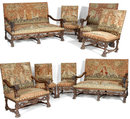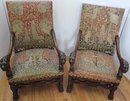Salon Set (2 settee, 2 armchairs, 2 side chairs) based on the Lady with the Unicorn




Unavailable
GoAntiques website does not offer sufficient space for the complete description and so you will need to visit the website for M. Markley Antiquest(we are prohibited from providing the web address but you can find it with any web search program). Sometimes in the antiques business, items strike a chord with past experiences and beloved images. Such was the case when we encountered this set at an auction in Paris. For both of us, the series of tapestries in the Cluny Museum (now the Museum of the Middle Ages) in Paris, The Lady with the Unicorn or La Dame à la Licorne is not only remarkable for the artistry but one of the best examples of how tapestries can be appreciated by modern viewers. Illustrating the five senses, the tapestries show the unicorn in various poses, either central to the action (as in the case of Sight and Touch), or as part of the pageantry in a heraldic, rampant pose (as in Taste or the Choosing of the Jewels). The unicorn, a cloven-footed horse with a goat's beard and a long fluted horn, was so wild and swift that no one could take it by chasing it. Rather, a maiden had to be left in the forest and the untamable beast would come to her and fall asleep on her lap, at which time the hunters would seize it. The miraculous capture was considered to symbolize the incarnation of Christ and tapestries showed the capture associated with the Annunciation. In the six tapestries comprising the Cluny series, the unicorn remains free but tame. In one of the few instances when the series has left France, it was on view at the Metropolitan Museum of Art in New York in 1974 with other unicorn-related tapestries from the Metropolitan and other museums. The show was a blockbuster. Seeing so many tapestries in one place, up close and personal, led to a lifetime of interest in tapestries and marveling at the ability to create in woven form realistic scenes and effects including deep perspective, detailed landscapes, and virtuosic renderings of running water and reflections in a mirror. When as newlyweds, we moved to Paris, one of our first stops was the Cluny Museum to be re-united with The Lady with the Unicorn and re-ignite our fascination with the art of tapestry. We love the millefleurs style of tapestries for their combination of rich decorative elements, such as the many species of flowers portrayed, but also for the inclusion of so many animals - a bestiary in cotton and wool. Each time we visit the Cluny, it is fun to look for the bunnies standing on their hind legs and rubbing their noses, looking off into the distance, or directly out at us, the viewers. Unlike many tapestries of the era around 1500, which were also designed in Paris but made in the workshops of Flanders, the millefleurs tapestries are self-contained, lacking landscape or context. In the case of the Lady with the Unicorn, there is a central mound in dark blue-green on which the human figures and the unicorn stand, sometimes with a lion, a dog, a civet, a monkey, and a few rabbits. The flowers and other vegetation depicted in this central mound are planted while those in the rose background, are sprigs and branches no longer attached to their roots. How bunnies must have loved this feast for their senses! The female figures depicted in the six tapestries blend into the background and emerge from it, their richly textured and patterned garments reflective of the value of textiles in the medieval world as treasures far more valuable than the furniture on which they were draped. The pieces making up this Salon Set reproduce some of the scenes from the Cluny collection but add others in the same style, presumably inspired by the Cluny tapestries but a newer interpretation. The designer has done a remarkable job of capturing the grace and beauty of the original tapestries in this rendering. Needlepoint has been used rather than tapestry, meaning that instead of the fabric being woven on a loom it has been stitched onto a canvas framework. The heads of the female figures are executed in petit point, a very fine stitch over single threads of needlepoint canvas. The pieces in our Salon Set collection consist of the following: Settee One - The Choosing of the Jewels, also known as A mon seul désir Settee Two - Hearing or L'ouie Armchair One - Taste or Le Gout Armchair Two -- Smell or L'Odorat Side Chair One - Not based on the Cluny set - depicts a woman with a harp Side Chair Two - Touch or LeToucher Side Chair Three - A variation on Taste or Le Gout Side Chair Four - Not based on the Clucy set - depicts a woman with animals Interestingly, one of the most touching and symbolic of the Cluny tapestries, the one depicting Sight or La Vue, is not present in this collection. In the Cluny collection, Sight is represented by the unicorn, its paws on the lady's lap, viewing its reflection in a mirror she holds and perhaps foreshadowing its capture by hunters waiting for it to fall asleep in her lap. Whether Sight was represented by a piece now missing from this set (perhaps there were originally six side chairs instead of four) is a mystery.
M. Markley Antiques
Spring, Texas
Dealer accepts: Check
Shipping: Negotiated with Seller



